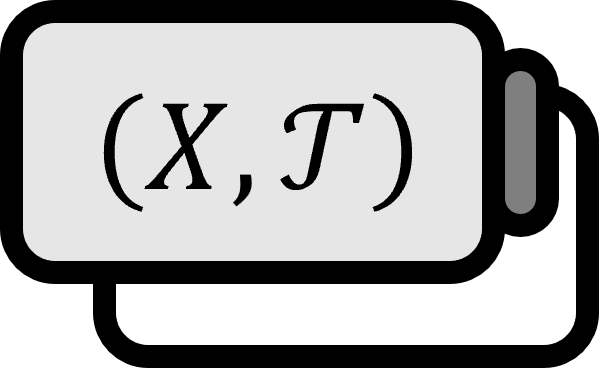Properties of Subspaces in Connected Spaces
Theorem
Let’s say about a topological space $X$ that $Y \subset X$.
- [1]: If $Y$ is a connected space, then $\overline{Y}$ is also a connected space.
- [2]: That $Y$ is a disconnected space is equivalent to the existence of open sets $U$ and $V$ in $X$ that satisfy $$ U \cap Y \ne \emptyset \\ V \cap Y \ne \emptyset \\ U \cap V \cap Y = \emptyset \\ Y \subset U \cup V $$.
- [3]: For a set $\left\{ A_{\alpha} \ | \ \alpha \in \forall \right\}$ of connected subspaces of $X$, if $$ \bigcap_{\alpha \in \forall} A_{\alpha} \ne \emptyset $$ then $\displaystyle \bigcup_{\alpha \in \forall} A_{\alpha}$ is a connected space.
- [4]: For a sequence $\left\{ A_{n} \ | \ n \in \mathbb{N} \right\}$ of connected subspaces of $X$, if $$ A_{n} \cap \left( \bigcup_{i=1}^{n-1} A_{i} \right) \ne \emptyset $$ then $\displaystyle \bigcup_{n = 1}^{\infty} A_{n}$ is a connected space.
Explanation
[2]
It’s good to visualize it because it’s long and hard to imagine.

Here $Y = Y_{1} \cup Y_{2}$. No matter how much you’ve studied topology, it’s not easy to imagine such a separated shape when you just say a subset. Instead of memorizing it as text, it’s better to accept the definition of disconnection as a fact.
[3]
The condition $\displaystyle \bigcap_{\alpha \in \forall} A_{\alpha} \ne \emptyset$ implies that at least one point is connecting everything. It may help to imagine pinning several cloths to the wall with a nail.
[4]
The condition $\displaystyle A_{n} \cap \left( \bigcup_{i=1}^{n-1} A_{i} \right) \ne \emptyset$ means the subspaces are connected in some way, even if indirectly. Think of it as an image where not every link in a chain is connected, but the overall structure is connected. Interpret it as a relaxation of the condition of the set itself in lieu of the given set in the statement [3], which is limited to countable sets.
By the way, statements [3] and [4] also hold true if ‘connected’ is replaced with ‘path-connected’.
Proof
[1]
Assume $\overline{Y}$ is a disconnected space.
Then, there exists a surjective and continuous function $f : \overline{Y} \to \left\{ a, b \right\}$. Consider $f|_{Y} : Y \to \left\{ a, b \right\}$, which limits the domain of this function to $Y$.
Since a discrete space $\left\{ a, b \right\}$ is not a connected space, by contraposition, either $Y$ is a disconnected space, or $f|_{Y}$ is not surjective or not continuous. However, since $Y$ is a connected space by premise and $f|_{Y}$ remains continuous, $f|_{Y}$ must not be surjective.
[If $f$ is continuous, for all $A \subset X$, $f( \overline{A} ) \subset \overline{ f(A) } $](../432)
That is, either $f(Y) = \left\{ a \right\}$ or $f(Y) = \left\{ b \right\}$, but since $f$ is continuous, $f( \overline{Y}) \subset \overline{ f(Y) } \ne \left\{ a , b \right\}$. This contradicts with $f$ being surjective, therefore, $\overline{Y}$ must be a connected space.
■
Meanwhile, the following useful corollary can be obtained:
If a subspace $Y$ of a topological space $X$ is a connected space, then $Z$ satisfying $Y \subset Z \subset \overline{Y}$ is a connected space.
[2]
$(\Rightarrow)$
Since $Y$ is a disconnected space, non-empty open spaces $A , B$ exist in $Y$ that satisfy $A \cap B = \emptyset$ and $A \cup B = Y$. Because $A$ and $B$ are open spaces, $$ U \cap Y =A \\ V \cap Y = B $$ an open space $U, V$ exists in $X$. Therefore, $$ U \cap Y \ne \emptyset \\ V \cap Y \ne \emptyset \\ U \cap V \cap Y = (U \cap Y) \cap (V \cap Y) = A \cap B = \emptyset $$ Meanwhile, $Y = A \cup B \subset U \cup V$.
$(\Leftarrow)$
Assuming open sets $U$ and $V$ exist in $X$ satisfying $$ U \cap Y \ne \emptyset \\ V \cap Y \ne \emptyset \\ U \cap V \cap Y = \emptyset \\ Y \subset U \cup V $$, and if $$ A := U \cap Y \\ B := V \cap Y $$, then $A, B$ is a non-empty open set in $Y$. Meanwhile, $$ A \cap B = (U \cap Y) \cap ( V \cap Y) = U \cap V \cap Y = \emptyset \\ A \cup B = (U \cap Y) \cup (V \cap Y) = ( U \cup V ) \cap Y = Y $$ Therefore, $Y$ is a disconnected space.
■
[3]
Assuming $\displaystyle \bigcap_{\alpha \in \forall} A_{\alpha} \ne \emptyset$, let’s assume $Y = \displaystyle \bigcup_{\alpha \in \forall} A_{\alpha}$ is a disconnected space. By statement [2], $$ U \cap Y \ne \emptyset \\ V \cap Y \ne \emptyset \\ U \cap V \cap Y = \emptyset \\ Y \subset U \cup V $$ open sets $U$ and $V$ exist in $X$. Then, $$ (U \cap A_{\alpha} ) \cup (V \cap A_{\alpha} ) = (U \cup V) \cap A_{\alpha} = A_{\alpha} \\ (U \cap A_{\alpha} ) \cap (V \cap A_{\alpha} ) = ( U \cap V) \cap A_{\alpha} = \emptyset $$ However, since $A_{\alpha}$ is assumed to be a connected space, either $(U \cap A_{\alpha} )$ or $(V \cap A_{\alpha} )$ must be empty. It doesn’t matter whether it’s $U$ or $V$, so let’s just say $(V \cap A_{\alpha} ) = \emptyset$. For any $A_{\alpha}$, $(V \cap A_{\alpha} ) = \emptyset$ so, $$ V \cap \bigcap_{\alpha \in \forall} A_{\alpha} = \emptyset $$ To put it clearly, $V \cap Y = \emptyset$, which contradicts the assumption.
■
[4]
Let’s say $n \le 2$ for a natural number.
Since $A_{1}$ is a connected space, $B_{2}$ is also a connected space, and by mathematical induction, $B_{n}$ is a connected space. $$ \emptyset \ne A_{2} \cap A_{1} \subset A_{1} \subset B_{n-1} \subset B_{n} $$ therefore, $$ \bigcap_{n=2}^{\infty} B_{n} \ne \emptyset $$ By statement [3], $\displaystyle \bigcup_{n = 1}^{\infty} A_{n} = \bigcup_{n = 2}^{\infty} B_{n}$ is a connected space.
■
